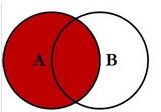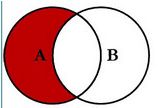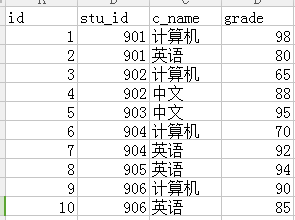一、数据的完整性之实体完整性
数据的完整性
作用:保证用户输入的数据保存到数据库中是正确的。
实质:创建表的时候给表中的字段添加约束。实体完整性
实体:表中的一行或者一条记录代表一个实体
实体完整性的作用:标识每一行数据不重复
约束类型:主键约束【primary key】、唯一约束【unique】、自动增长列【auto_increment】-
主键约束【primary key】
特点:数据唯一,且不能为null;
它的值用来唯一标识表中的某一条记录;
场景:在多个表的关联关系中;// id设置为主键 create table student(id int, name varchar(50), primary key(id)); -
唯一约束【unique】
作用:在非主键列中不能输入重复的值;create table student(id int primary key, name varchar(50) unique);primary key和unique之间的区别?
- 二者都强调的是唯一性
- 在同一个表中,只能出现一个primary key,可以出现多个unique
- primary key不允许为null,但是unique是允许的
-
自动增长【auto_increment】
给主键添加添加自动增长性,字段只能是整数类型;
场景: 一般添加给主键;create table student(id int primary key auto_increment, name varchar(50) unique);
二、数据的完整性之域完整性
域完整性
作用:限制单元格数据的正确性,域代表当前单元格;
约束类型:数据类型、非空约束【not null】、默认值约束【default】-
数据类型
数字类型:int float doule decimal 日期类型:date 字符串类型:char varchar -
非空约束【not null】
create table student( id int primary key auto_increment, name varchar(50) not null);非空,即表示插入数据时不能为空;为空时,数据库立即报错。
-
默认值约束【default】
create table student(id int primary key auto_increment, name varchar(50), addr varchar(50) default "shenzhen") // 不使用默认值 insert into student (id,name, addr) values(1,'aaa','guagnzhou'); // 使用默认值 insert into student(id,name, addr) values(2,'bbb',default); insert into student(id,name) values(3,'ccc');
二、数据的完整性之引用完整性
-
外键约束【foreign key】
注意: 添加外键必须先有主键,主键和外键的类型必须保持一致;
作用: 将两个甚至多个毫无关联的表产生联系
备注: 一张表中可以有多个外键
例如: 学生表,成绩表// 创建学生表 create table student(stu_id int primary key, s_name varchar(50)) charset=utf8; // 添加学生数据 insert into student values(1001, '张三'); insert into student values(1002, '李四'); insert into student values(1003, '王五'); insert into student values(1004, '赵六'); insert into student values(1005, '田七'); insert into student values(1006, '王八'); insert into student values(1007, '老九'); // 创建成绩表 // 外键stu_id,外键约束对应的student的stu_id create table score(sco_id int primary key, score int, stu_id int,foreign key(stu_id) references student(stu_id)) charset=utf8; insert into score values(1, 89, 1001); insert into score values(2, 97, 1002); insert into score values(3, 99, 1003); insert into score values(4, 82, 1004); insert into score values(5, 86, 1005);
四、多表查询
-
表与表之间的关系
- 一对一, 通过嵌套的方式
- 一对多(多对一), 添加外键
- 多对多, 单独创建一张新的表
-
合并结果集
作用:将两个select语句的查询结果合并到一起;
两种方式:union去除重复记录【并集】、union all获取所有的结果;// 创建表A和表B create table A( name varchar(10), score int ); create table B( name varchar(10), score int ); // 插入数据 insert into A values('a',10),('b',20),('c',30); insert into B values('a',10),('d',40),('c',30); // union合并结果集 select * from A union select * from B; +------+-------+ | name | score | +------+-------+ | a | 10 | | b | 20 | | c | 30 | | d | 40 | +------+-------+ // union all合并结果集 select * from A union all select * from B; +------+-------+ | name | score | +------+-------+ | a | 10 | | b | 20 | | c | 30 | | a | 10 | | d | 40 | | c | 30 | +------+-------+ // 问题: 如果遇到列数不相同的情况 create table C( name varchar(10), score int, age int); insert into C values('a',100,29),('e',20,18),('c',300,10); insert into C values('a',10,29),('e',20,18),('c',30,10); select * from A union select name,score from C; +------+-------+ | name | score | +------+-------+ | a | 10 | | b | 20 | | c | 30 | | a | 100 | | e | 20 | | c | 300 | +------+-------+注意:被合并的两个结果,字段、字段类型必须相同;
-
内连接inner join
内连接:查询左右表都有的数据,不要左右中空的那一部分;
内连接:左右连接的交集;语法: select 列1,列2,列N from tableA inner join tableB on tableA.列 = tableB.列 (此处表连接成一张大表,完全当成一张普通表看) where,having,group by.... (条件照常写) 例如: 查询每个学生的具体信息 select tableA.*,tableB.score from student tableA inner join score tableB on tableA.stu_id=tableB.stu_id; select tableA.*,score from student tableA inner join score tableB on tableA.stu_id=tableB.stu_id; -
左连接left join
左连接1: 得到的是A的所有数据,和满足某一条件的B的数据;左连接2: 得到的是A中的所有数据减去"与B满足同一条件 的数据",然后得到的A剩余数据;
语法:
select
列1,列2,列N
from
tableA
left join
tableB
on
tableA.列 = tableB.列 (此处表连接成一张大表,完全当成一张普通表看)
where,having,group by.... (条件照常写)
例如,左连接1:
select
tableA.*,score
from
student tableA
left join
score tableB
on
tableA.stu_id=tableB.stu_id;
例如,左连接2:
select
tableA.*
from
student tableA
left join
score tableB
on
tableA.stu_id=tableB.stu_id
where
score is null;
-
右连接right join
右连接1: 得到的是B的所有数据,和满足某一条件的A的数据;右连接2: 得到的是B中的所有数据减去 "与A满足同一条件的数据",然后得到的B剩余数据;
语法: select 列1,列2,列N from tableA right join tableB on tableA.列 = tableB.列 (此处表连接成一张大表,完全当成一张普通表看) where,having,group by.... (条件照常写) 例如: select tableA.*,score from student tableA right join score tableB on tableA.stu_id=tableB.stu_id;左连接:即以左表为基准,到右表找匹配的数据,找不到匹配的用NULL补齐;
推荐左连接来代替右连接,兼容性会好一些; -
自然连接natural join
通过MySql自己的判断完成连接过程,不需要指定连接条件。MySql会使用表内的,相同的字段,作为连接条件。select * from A natural join B;
五、多表查询
1、男同学的考试科目及对应成绩
2、姓张同学的考试科目及对应成绩
3、既有英语又有计算机成绩的学生信息
4、姓王的同学并且有一科以上成绩大于90分的学生信息
5、查询李四的考试科目(c_name)和考试成绩(grade)
6、查询计算机成绩低于95的学生信息
7、查询都是湖南的学生的姓名、年龄、院系和考试科目及成绩
1、
SELECT name,sex,c_name,grade
FROM
student,score
WHERE
student.id=score.stu_id AND sex='男';
2、
SELECT name,c_name,grade
FROM
student,score
WHERE
student.id=score.stu_id AND name LIKE "张%";
3、
SELECT student.*
FROM
student,score s1,score s2
WHERE
student.id=s1.stu_id AND student.id=s2.stu_id
AND
s1.c_name="计算机" AND s2.c_name="英语";
4、
SELECT student.*
FROM
student,score
WHERE
student.id=score.stu_id AND grade>90 AND name LIKE "王%";
5、
SELECT name,c_name,grade
FROM
student,score
WHERE
student.id=score.stu_id AND name="李四";
6、
SELECT student.*,c_name,grade
FROM
student,score
WHERE
student.id=score.stu_id AND c_name="计算机" AND grade<95;
7、
SELECT name,2017-birth AS age,department,c_name,grade
FROM
student,score
WHERE
student.id=score.stu_id AND address like "%湖南%";
找到表与表的对应关系;
如果多张表中有同一个属性名时必须标注是哪个表中的属性;
六、数据库的备份和恢复
-
备份
生成SQL脚本,导出数据。语法: $ mysqldump -u root -p 数据库名 > 生成sql脚本的路径 例如: $ mysqldump -u root -p mydb1 > ~/mydb1.sql -
恢复
执行sql脚本,恢复数据。前提: 必须先创建数据库【空的】 注意: 需要先登录数据库,然后进入指定的数据库,执行sql脚本 语法: mysql> source sql脚本的路径 例如: mysql> create database test; mysql> use test; mysql> source ~/mydb1.sql;
八、MySQL与Python的交互
- 安装
pip3 install pymysql
- 使用
import pymysql
# 链接数据库
db = pymysql.Connect(host='127.0.0.1', port=3306, user='root', password='123456', database='test08', charset='utf8')
# 数据库游标
cursor = db.cursor()
# 查询数据
db.begin()
cursor.execute("select * from students_info;")
db.commit()
# 获取所有数据
print(cursor.fetchall())
# 获取一个,根据下标取对应的数据
print(cursor.fetchall()[0])
# 注: 不能同时使用,因为游标会往后移动
# 插入数据
db.begin()
cursor.execute("insert into students_info values ('2000', '老李', '18', '男', '广东深圳', '1703', '89', '90', '81');")
db.commit()
# 更新数据
db.begin()
cursor.execute("update students_info set class='1807' where id=2000")
db.commit()
# 删除数据
db.begin()
cursor.execute("delete from students_info where id=2000")
db.commit()
作者:EndEvent
链接:https://www.jianshu.com/p/b29532e30f83
來源:
著作权归作者所有,任何形式的转载都请联系作者获得授权并注明出处。






